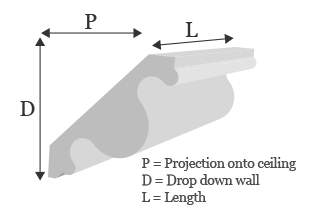
Cornices will make a design statement to any room like no other single decorative element.
This has been long understood by interior designers, architects and astute house builders alike. From modern interiors to traditional period design, cornice has no equal where style really matters. It provides the feel, look and finish you desire every single time.
“I could never imagine living in a room without cornice, now that I know how beautiful it really looks.”
This is the most common statement we hear from our clients when they experience the effect cornice has on their newly decorated room for the first time. With thousands of decoration projects to our credit over the past forty years, we invite you to view our vast collection of cornice mouldings today.
We highly recommend a showroom visit where you can view our complete selection of exquisite plaster mouldings.
Tip one: choose by design
As obvious as it sounds, our first tip is to choose the cornice you’re drawn to. Remember there are hundreds of cornice types to suit everyone, so trust your eyes and select the cornice that gives you the best feeling as you would a colour, carpet wall tiles or sofa etc.
Tip two: choose by period
Maybe you know the period or age of your building and would like to install cornicing that reflects this, or simply try to recreate a particular look. We have separated our cornice range into six main period types that will accommodate most design choices.
Remember we can also produce custom made mouldings to any requirements should you have more specific designs examples in mind, this includes matching to existing details and of course restoration work. Many of our stock ‘period’ cornice mouldings are authentic and taken from original examples as part of our many restoration projects.
Tip three: choose by size
As with tip one, selecting the size of your cornice is a matter of personal choice, however here’s a little advice that should help:
The most common mistake made when choosing cornice is to select a design that is too small in relation to the proportion of the room. Your architectural details such as architraves, skirting's, picture rails etc. are supposed to be seen as these are the elements that give your building its true character, before adding your furnishings.
It’s natural to see a sample of cornice held in the hand as to big, so we advise to pin your sample in place and see how it feels. About 24 to 48 hours later you'll be amazed at how quickly a larger cornice just starts to look right.
Remember we’re always happy to help you in any way, so call us today and let’s talk plaster!